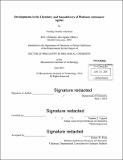| dc.contributor.advisor | Stephen J. Lippard. | en_US |
| dc.contributor.author | Johnstone, Timothy Charles | en_US |
| dc.contributor.other | Massachusetts Institute of Technology. Department of Chemistry. | en_US |
| dc.date.accessioned | 2014-10-21T17:26:47Z | |
| dc.date.available | 2014-10-21T17:26:47Z | |
| dc.date.copyright | 2014 | en_US |
| dc.date.issued | 2014 | en_US |
| dc.identifier.uri | http://hdl.handle.net/1721.1/91111 | |
| dc.description | Thesis: Ph. D. in Biological Chemistry, Massachusetts Institute of Technology, Department of Chemistry, 2014. | en_US |
| dc.description | Cataloged from PDF version of thesis. | en_US |
| dc.description | Includes bibliographical references. | en_US |
| dc.description.abstract | Approximately half of all patients receiving cancer chemotherapy are treated with a platinum-containing drug. Despite this intense clinical use, only three platinum complexes, cisplatin, carboplatin, and oxaliplatin, are approved by the United States Food and Drug Administration for the treatment of cancer. A number of side effects accompany platinum-based therapy and novel approaches are under investigation to attenuate these negative effects and circumvent tumor resistance, be it inherent or acquired. One approach is to use non-classical platinum agents such as platinum(IV) prodrugs and monofunctional platinum(II) complexes. The latter, unlike the classical platinum drugs, can only form one bond to the biological target, DNA. Another strategy is to exploit the advantages offered by nanodelivery. The work presented here spans a range of topics aimed at furthering the development of platinum anticancer therapy along these lines. Fundamental platinum chemistry has been explored to provide ready access to platinum(II) starting materials such as oxaliplatin and mixed ammine/amine platinum(II) complexes. Novel platinum(IV) architectures were uncovered while investigating the oxidative halogenation of cisplatin and carboplatin. Nanoparticle constructs based on the biocompatible amphiphilic block copolymer, PLGA-PEG, have been devised that are capable of delivering both hydrophobic and hydrophilic platinum complexes. Nanoparticle encapsulation has a significant effect on the in vivo properties of the platinum(IV) prodrug mitaplatin. Fundamental studies of the chirality of a potent monofunctional complex, phenanthriplatin, revealed aspects of its interaction with derivatives of the nucleobase guanine, that may have a significant effect on the cellular processing of the DNA adducts formed by this compound. Finally, nanoparticle delivery was used to enhance the ability of phenanthriplatin and phenanthriplatin prodrugs to inhibit the growth of tumors in mice. | en_US |
| dc.description.statementofresponsibility | by Timothy Charles Johnstone. | en_US |
| dc.format.extent | 376 pages | en_US |
| dc.language.iso | eng | en_US |
| dc.publisher | Massachusetts Institute of Technology | en_US |
| dc.rights | M.I.T. theses are protected by copyright. They may be viewed from this source for any purpose, but reproduction or distribution in any format is prohibited without written permission. See provided URL for inquiries about permission. | en_US |
| dc.rights.uri | http://dspace.mit.edu/handle/1721.1/7582 | en_US |
| dc.subject | Chemistry. | en_US |
| dc.title | Developments in the chemistry and nanodelivery of platinum anticancer agents | en_US |
| dc.type | Thesis | en_US |
| dc.description.degree | Ph. D. in Biological Chemistry | en_US |
| dc.contributor.department | Massachusetts Institute of Technology. Department of Chemistry | |
| dc.identifier.oclc | 892966868 | en_US |
